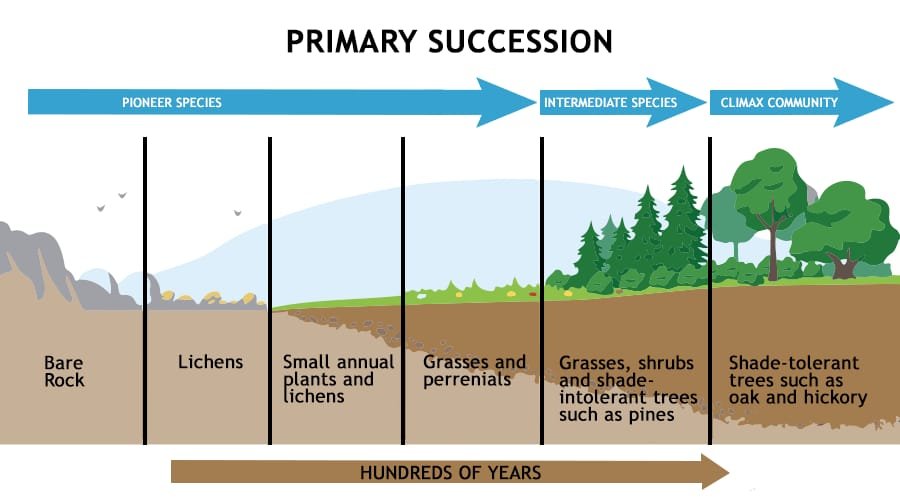MCQ ON ECOLOGICAL SUCCESSION class 12 for NEET | ECOLOGICAL SUCCESSION class 12 | MCQ ECOLOGICAL SUCCESSION with Answer | Check the below NCERT MCQ question for class 12 Biology based on the with Answers.

MCQ ON ECOLOGICAL SUCCESSION class 12 for NEET
MCQ on ECOLOGICAL SUCCESSION class 12 Biology with answers were prepared based on the latest pattern.We have provided class 12 Biology MCQs questions on ECOLOGICAL SUCCESSION with Answers to help students understand the concept very well.
MCQ ON ECOLOGICAL SUCCESSION is useful for NEET / CSIR / UGC / CBSE / ICSE / AIIMS / EXAM / AFMC EXAM / STATE LEVEL MEDICAL EXAM 2022-23, 2023-24
Introduction:
Important characteristic of all community is died their composition and structure constantly change in response to the changing in environmental conditions. This change is orderly and sequential parallel with a changes in the physical environment. This changes laid finally to a community that is in near equilibrium be the environment and that is called climax communities. The gradual and fairly predictable change in a species composition of given area is called ecological succession. During succession some species colonize in area and their population become more numerous where is populations of other species decline and even disappear. Entire sequence of community that successively change in a given area are called seres. The individual transitional community are termed seral stages or seral communities. The present day community in the world have come to be because of the succession that has occurred over millions of years since life started on earth. Success a process that starts in an area where no living organisms are there which could be areas where no living organism ever existed ,say bare rock or in areas that somehow lost all the living organisms that existed there.
MCQ ON ECOLOGICAL SUCCESSION class 12 for NEET
1. The gradual and fairly predictable change in the species composition of a given area is called
(a) climax community
(b) ecological succession
(c) sere
(d) Pioneer species
Ans (b) ecological succession
2. The entire sequence of communities that successively change in a given area are called
(a) ecological succession
(b) climax community
(c) seres
(d) Pioneer species
Ans. (c) seres
3. Examples of areas where primary succession occurs are
(a) newly cooled lava
(b) bare rock
(c) newly created pond or reservoir
(d) all the above
Ans. (d) all the above
4. Succession a process that starts in an area where no living organisms are there-could be areas where no living organisms ever existed say bare rock. It is called
(a) primary succession
(b) secondary succession
(c) Pioneer species
(d) tertiary succession
Ans.(a) primary succession
5. The changes lead finally to a community that is in near equilibrium be the environment and that is called
(a) climax community
(b) seres
(c) ecological succession
(d) Pioneer species
Ans.(a) climax community
6. Hydrarch succession takes place in
(a) dry areas
(b) wet areas
(c) hot areas
(d) cold areas
Ans.(b) wet areas
7. Xerarch succession takes place in
(a) wet areas
(b) dry areas
(c) moist areas
(d) all the above
Ans.(b) dry areas
8. Species that invade a bare areas are called
(a) Pioneer species
(b) seres
(c) xerarch succession
(d) hydrarch succession
Ans.(a) Pioneer species
9. The succession begin in the areas where natural biotic communities have been destroyed such as in abundant farmlands burned or cut forests , lands that have been flooded.
(a) primary succession
(b) secondary succession
(c) seres
(d) Pioneer species
Ans. (b) secondary succession
10. Ine primary succession in water the pioneers are the small
(a) zooplankton
(b) phytoplankton
(c) lichen
(d) all the above
Ans. (b) phytoplankton
11. In secondary succession the species that invaded depend on the
(a) condition of the soil
(b) availability of water
(c) the environment
(d) all the above
Ans.(d) all the above
12. Which is correct about characteristic of succession
(a) primary succession is a very slow process
(b) prime succession taking may be thousands of years for the climax community to be reached
(c) all succession whether taking place in water or land proceeds to a similar climax community the mesic
(d) all the above
Ans . (d) all the above
13. Phytoplankton is component of
(a) pond ecosystem
(b) desert ecosystem
(c) grass ecosystem
(d) forest ecosystem
Ans.(a) pond ecosystem
14. Ultimate source of energy for living beings is
(a) carbohydrate
(b) protein mil jaega
(c) fats
(d) sun
Ans. (d) sun
15. Great barrier reef along east coast of Australia is
(a) population
(b) community
(c) biome
(d) ecosystem
Ans.(d) ecosystem
16.An Ecosystem is not
(a) open system
(b) closed system
(c) variable system
(d) none of the above
Ans.(b) closed system
17. Major forest type found in India is
(a) sub tropical deciduous
(b) tropical moist deciduous
(c) tropical deciduous
(d) temperate deciduous
And.(c) tropical deciduous
18. Most primary productivity of pond is by
(a) phytoplankton
(b) zooplankton
(c) floating plants
(d) red algae
Ans. (a) phytoplankton
ALSO READ:-
● YOU CAN WATCH BIOLOGY SIR Youtube channel
19. Ecosystem contains
(a) food web
(b) food chain
(c) both a and b
(d) none of the above
Ans.(c) both a and b
20. Earthworm is a
(a) herbivore
(b) secondary consumer
(c) tertiary consumer
(d) detrivores
Ans.(d) detritivores
21. Secondary productivity rate of formation of new organic matter by
(a) producers
(b) consumers
(c) decomposers
(d) carnivores
Ans.(b) consumers







Leave a Comment